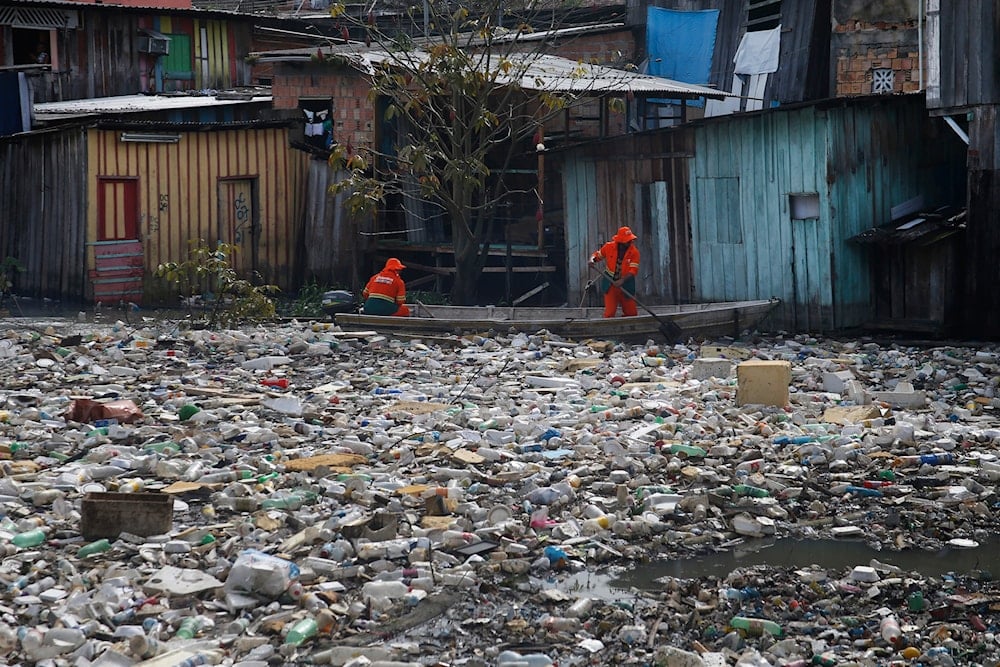Plastic crisis fuels pollution, illness, and climate chaos
A major expert review warns that plastic pollution causes disease, premature death, and costs trillions, urging urgent action as treaty talks face industry pushback.
-

City workers remove garbage floating on the Negro River, which has a rising water level due to rain, in Manaus, Amazonas state, Brazil, June 6, 2022. (AP)
A comprehensive new expert review has declared plastics a “grave, growing and under-recognized danger” to both human and environmental health.
The world is currently grappling with a “plastics crisis", the report states, one that inflicts disease and premature death across the entire lifespan, from infancy through old age, and costs at least $1.5 trillion annually in health-related damages.
At the heart of this mounting crisis is the explosive growth of plastic production. Since 1950, global output has increased more than 200-fold and is projected to nearly triple again by 2060, surpassing one billion tonnes per year.
Researcher Laura Simon-Sánchez said: "Specifically, the results show that, since 2000, the amount of #plastic particles deposited on the #seafloor has tripled and that, far from decreasing, the accumulation has not stopped growing..." pic.twitter.com/nhXjcRs9vR
— Al Mayadeen English (@MayadeenEnglish) February 4, 2023
Although plastic remains indispensable in many industries, the most significant rise has occurred in single-use products such as beverage bottles and takeaway packaging.
Pollution spans the globe, recycling remains negligible
The resulting environmental fallout has been staggering. According to the review, plastic waste, estimated at 8 billion tonnes, now contaminates every corner of the Earth, from the summit of Mount Everest to the bottom of the Mariana Trench. Alarmingly, less than 10% of this waste is recycled.
The study underscores that plastics endanger both people and ecosystems at every phase: from fossil fuel extraction and manufacturing to use and disposal. These processes contribute to air pollution, release toxic chemicals, and introduce microplastics into the human body. Moreover, discarded plastic items often collect water, creating breeding grounds for disease-carrying mosquitoes.
The findings were published in The Lancet just ahead of the sixth, and potentially final, round of global negotiations aimed at establishing a legally binding treaty on plastic pollution. Progress has been hampered by a rift between over 100 nations advocating for a cap on plastic production and a handful of petrostates, including Saudi Arabia, that oppose such limits. Recent reporting by The Guardian has revealed how petrochemical lobbyists are actively undermining these negotiations.
Children bear the brunt of health toll
“We know a great deal about the range and severity of the health and environmental impacts of plastic pollution,” said Prof Philip Landrigan, a paediatrician and epidemiologist at Boston College and lead author of the report.
He emphasized that any treaty must incorporate strong provisions to safeguard human and planetary health. “The impacts fall most heavily on vulnerable populations, especially infants and children,” he added. “They result in huge economic costs to society. It is incumbent on us to act in response.”
Oil-producing states and industry stakeholders have argued that efforts should focus on improving recycling, rather than cutting production. But unlike more easily recyclable materials such as paper or aluminum, plastic’s chemical complexity makes large-scale recycling largely unviable. “It is now clear that the world cannot recycle its way out of the plastic pollution crisis,” the report stated.
More than 98% of plastics originate from fossil fuels, oil, gas, and coal. The energy-intensive process of producing plastic generates around 2 billion tonnes of CO₂ emissions each year, a volume exceeding Russia’s total emissions. Beyond climate impact, production also contributes to hazardous air pollution. In many regions, over half of the plastic waste is openly burned, further degrading air quality.
Toxic chemicals, long-term exposure risks
The report notes that over 16,000 chemicals are used in plastics, including dyes, flame retardants, stabilizers, and fillers. Many are associated with serious health risks, yet transparency remains lacking. The authors stressed the need for clearer data on the chemical makeup of plastic materials.
Microscopic fragments of plastic are now ubiquitous, infiltrating human bodies through ingestion, inhalation, and even placental transfer. Traces of micro- and nanoplastics have been detected in the bloodstream, breast milk, semen, brain tissue, and bone marrow. Though their long-term health effects remain poorly understood, early links to strokes and cardiovascular disease have prompted calls for a precautionary approach.
Hidden costs of 'cheap' plastic
Despite its reputation as a low-cost material, plastic carries immense hidden costs. A previous estimate placed the annual health burden from just three plastic-associated chemicals, PBDE, BPA, and DEHP, at $1.5 trillion across 38 countries.
The newly released report is the first in a planned series that will monitor and evaluate the impacts of plastic pollution over time.
Margaret Spring, senior legal advisor and co-author of the study, said the aim is to equip global policymakers with “a robust and independent data source to inform the development of effective policies addressing plastic pollution at all levels.”

 5 Min Read
5 Min Read










